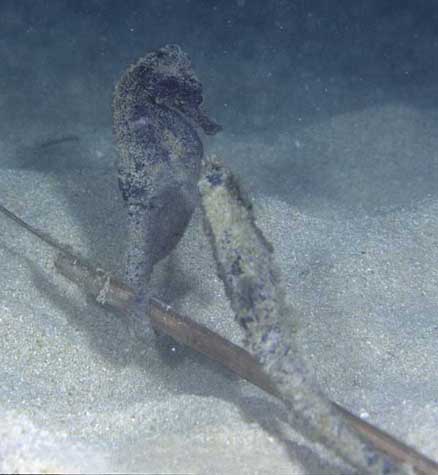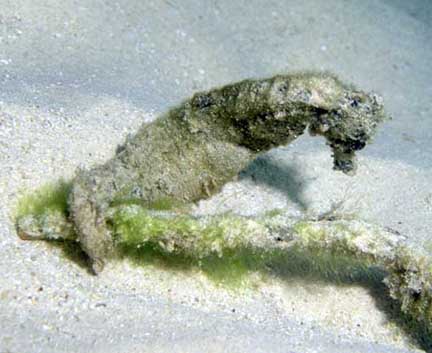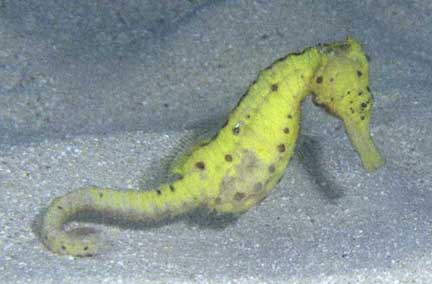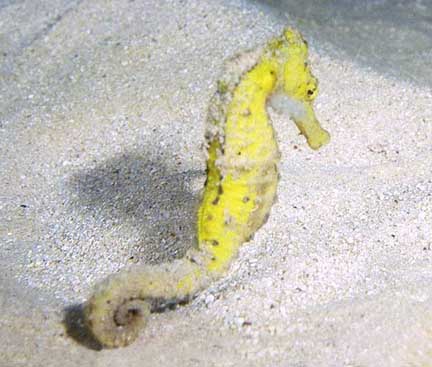|
hawaiisfishes.com
|
|
Home |
Fishes | Invertebrates |
Books | CDs
| Links |
Contact |
|
past
fishes of the month
SMOOTH SEAHORSE
|
 |
| SMOOTH
SEAHORSE Hippocampus kuda Bleeker, 1852 If you dive or snorkel in Hawai`i, when was the last time you found a seahorse? For almost everyone, even dedicated fish-watchers who hit the water every day, the answer is "I've never found a seahorse in Hawai`i." Despite their inclusion in the fish books, seahorses are just never seen in the Islands. Well, almost never. Once many years ago I found a Featherduster Worm in Kane`ohe Bay with a shapeless blackish glob fastened on to its tube. It was in less than a foot of water. Wondering what the glob was, I reached down and removed it, whereupon it straightened out and revealed itself as a dark gray seahorse well camouflaged with a thin coat of filamentous algae and silt. Delighted and amazed, I took the seahorse home to my aquarium where it soon gave birth to hundreds of tiny seahorses--it was a pregnant male! The next day I gave it, and the babies, to the Waikiki Aquarium. The event was so unusual it was written up in the paper. Later, I read that the first thing that new-born seahorses do is rise to the surface to gulp a tiny bubble of air which helps keep them vertical in the water. I put this factoid in my book, Hawaii's Fishes, but have never been able to verify it. It makes a certain amount of sense, though, because this male, about to give birth, was in extremely shallow water in a very protected location--perfect for his offspring to get that little gulp of air. |
 |
|
Almost 20 years passed before I saw my next Hawaiian seahorse. It was last weekend. A friend called with some excitement to tell me that she had seen 5 of them, including one yellow one, at the place where she swims several times a week. Although she has decades of Hawaiian diving under her belt, worked for years as a professional fish collector in Hawai`i, and is close to her PhD in ichthylogy at the University of Hawai`i, she had never once seen a seahorse in Hawai`i. Five seahorses was totally unheard of, absolutely insane. I went out with her the next morning fully expecting that they would be gone, but after a bit of swimming around she found two dark ones holding on to a bit of palm frond. They were over sand in about 8-10 ft. of water and would have been easy to miss, looking, as they did, like bits of weed or drifting black crud. Later, after considerable searching, she found the another dark one and the yellow one, also over sand. Interestingly, all appeared to have swollen abdomens and might have been pregnant males, though I can't be sure. All had light coats of algae and silt. |
 |
| Had they been there all along? Maybe, but surely my eagle-eyed friend would have spotted them before. And she is by no means the only person who swims regularly at this popular spot. So, if they hadn't been there, where had they come from? Do they live in deep water and swim in to shallow, sheltered spots at certain times of year, briefly, to give birth? One was seen and photographed inside the reef at Hanauma Bay a couple of years ago and it disappeared within a day. Although seahorses aren't great swimmers, these ones had no problem evading me when I swam down to try to take photos. It's not inconceivable that they could migrate. But if they live in deeper water why do scuba divers never see them? One of O`ahu's most popular shore dive sites is not far from this spot, swarming with camera-carrying divers. If there were seahorses out there people would be seeing them. It's a mystery. |
 |
|
The other species recorded from the Islands is Hippocampus kuda, known as the Smooth Seahorse because it lacks spines. Another common name is Yellow Seahorse. This seems to be what we were seeing. The species grows to about 12 in., though ours were more like 5-6 in. long. Hippocampus kuda occurs throughout the Indo-Pacific region, though seahorse specialists have raised the possibility that it is not a single species at all but a species complex with several geographical variants which might in the future be elevated to full species rank. If that's the case, the Hawaiian kudas might someday be given another name and maybe even be declared endemic. A third species, the sometimes pelagic Hippocampus histrix, was recorded from Maui once in the 1920s, Some marine animals in Hawai`i go through cycles of abundance and scarcity. The Fantail Filefish is one example. Most years it is uncommon to moderately common, but every several decades it occurs in plague proportions. The Oval or Bigfin Squid is another example. For decades it was almost absent from our reefs, but in the last few years the species has became almost common around O`ahu. The Smooth Seahorse may fit into this pattern. Perhaps it's undergoing a population bloom of some sort after decades of scarcity. Next time you are snorkeling in a well-protected shallow spot keep an eye out for seahorses. |
|
|